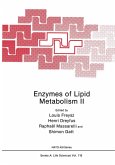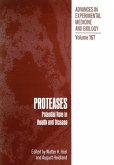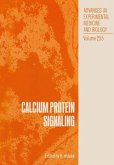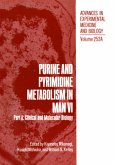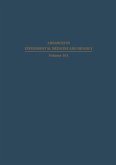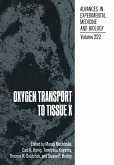Bradykinin and Related Kinins
Cardiovascular, Biochemical, and Neural Actions
Herausgegeben von Sicuteri, F.
Bradykinin and Related Kinins
Cardiovascular, Biochemical, and Neural Actions
Herausgegeben von Sicuteri, F.
- Broschiertes Buch
- Merkliste
- Auf die Merkliste
- Bewerten Bewerten
- Teilen
- Produkt teilen
- Produkterinnerung
- Produkterinnerung
At the turn of the present century, researchers recognized that dall1aged tissue released chell1ical agents capable of causing catastrophic effects on the whole organisll1 upon enter ing the blood streall1. Following the discovery of histall1ine, these agents at first seell1ed identifiable with biogenic all1ines. However, very soon after the developll1ent of highly selective antagonists, little responsibility was ascribed to the all1ines, and the tissue factors were wrapped once again in ll1ystery. One can ill1agine perhaps and envy the fascinating ll1Oll1ents experienced by the ?ioneers in…mehr
Andere Kunden interessierten sich auch für
![Enzymes of Lipid Metabolism II Enzymes of Lipid Metabolism II]() Louis FreyszEnzymes of Lipid Metabolism II77,99 €
Louis FreyszEnzymes of Lipid Metabolism II77,99 €![PROTEASES: Potential Role in Health and Disease PROTEASES: Potential Role in Health and Disease]() PROTEASES: Potential Role in Health and Disease39,99 €
PROTEASES: Potential Role in Health and Disease39,99 €![Calcium Protein Signaling Calcium Protein Signaling]() Calcium Protein Signaling77,99 €
Calcium Protein Signaling77,99 €![Purine and Pyrimidine Metabolism in Man VI Purine and Pyrimidine Metabolism in Man VI]() Purine and Pyrimidine Metabolism in Man VI77,99 €
Purine and Pyrimidine Metabolism in Man VI77,99 €![Enzymes of Lipid Metabolism Enzymes of Lipid Metabolism]() Enzymes of Lipid Metabolism77,99 €
Enzymes of Lipid Metabolism77,99 €![Oxygen Transport to Tissue X Oxygen Transport to Tissue X]() Oxygen Transport to Tissue X78,99 €
Oxygen Transport to Tissue X78,99 €![Oxygen Transport to Tissue VIII Oxygen Transport to Tissue VIII]() Oxygen Transport to Tissue VIII77,99 €
Oxygen Transport to Tissue VIII77,99 €-
-
-
At the turn of the present century, researchers recognized that dall1aged tissue released chell1ical agents capable of causing catastrophic effects on the whole organisll1 upon enter ing the blood streall1. Following the discovery of histall1ine, these agents at first seell1ed identifiable with biogenic all1ines. However, very soon after the developll1ent of highly selective antagonists, little responsibility was ascribed to the all1ines, and the tissue factors were wrapped once again in ll1ystery. One can ill1agine perhaps and envy the fascinating ll1Oll1ents experienced by the ?ioneers in the kinin field when they realized that plasll1a had an enorll1OUS store of principles endowed with biologic activity, practically indistinguishable froll1 histall1ine, possessing a cOll1plex turnover and regulated by obscure biochell1icalll1echanisll1s. Like other biochell1ical eras, the era of the kinins was opened by a pioneer stage exceptionally long and exciting. After years of arduous isolation, researchers realized that kinins ll1ay not only be the key to unlocking the ll1ystery of histall1ine -like substance s, but alsoll1ay open the way to understanding other basic problell1s in pathology possibly associated with tissue factors.
Produktdetails
- Produktdetails
- Advances in Experimental Medicine and Biology .8
- Verlag: Springer / Springer US / Springer, Berlin
- Artikelnr. des Verlages: 86064505, 978-1-4684-3200-8
- 1970
- Seitenzahl: 680
- Erscheinungstermin: 12. Dezember 2012
- Englisch
- Abmessung: 254mm x 178mm x 37mm
- Gewicht: 1257g
- ISBN-13: 9781468432008
- ISBN-10: 1468432001
- Artikelnr.: 37479334
- Herstellerkennzeichnung
- Springer-Verlag GmbH
- Tiergartenstr. 17
- 69121 Heidelberg
- ProductSafety@springernature.com
- Advances in Experimental Medicine and Biology .8
- Verlag: Springer / Springer US / Springer, Berlin
- Artikelnr. des Verlages: 86064505, 978-1-4684-3200-8
- 1970
- Seitenzahl: 680
- Erscheinungstermin: 12. Dezember 2012
- Englisch
- Abmessung: 254mm x 178mm x 37mm
- Gewicht: 1257g
- ISBN-13: 9781468432008
- ISBN-10: 1468432001
- Artikelnr.: 37479334
- Herstellerkennzeichnung
- Springer-Verlag GmbH
- Tiergartenstr. 17
- 69121 Heidelberg
- ProductSafety@springernature.com
In Vitro Investigations on Some Components of the Kinin System (Kininogen, Serum Kallikrein, Hageman Factor), and Their Interaction.- Observations on Plasma Kinin Forming Enzymes.- Liberation Mechanisms of Kinins in Bovine Plasma.- Application of Water-Insoluble Complexes of Kininogenases, Inhibitors and Kininases to Kinin Research.- Kinin Formation in Human Blood Serum Induced by Cooling and by Heat Aggregated Human Gamma Globulin Preparations.- Kinin Metabolism in Normal and Malignant Leucocytes.- Optical Activity and Conformation of Bradykinin and Related Peptides.- Studies on Antibody to Bradykinin.- Partial Purification of Rat Urinary Kininogenase and Its Reactions with Active Center Reagents of Trypsin.- Kininogenic and Oxytocic Properties of Rat Pancreatic Juice.- Bradykinin-Potentiating Peptides from the Venom of Bothrops jararaca.- Active Pharmacological Principle Released by Different Enzymatic Preparations from Bothrops jararaca Plasma.- Structure of Bradykinin Potentiating Peptides from the Venom of Agkistrodon halys blomhoffii.- Biochemistry of Kinin-Releasing Enzymes in the Venom of the Viper Bitis gabonica and of the Lizard Heloderma suspectum.- The Occurrence in Plasma of a Protein with Kinin-Like Activity.- The Isolation and Partial Characterization of Kinin-Forming Enzymes and Other Active Components from Human Plasma.- Modification of the Reactivity of Guinea-Pig Seminal Vesicles to Angiotensin and Tyramine by Some Microsomal Enzyme Inducers.- A Kinin-Like Forming Enzyme in Saliva Presenting a Potent Oxytocic Activity.- Significance of Kinins in the Coronary Circulation.- Comparative Cardiac Effects of Angiotensin, Eledoisin and Physalaemin.- Effects of Bradykinin, Eledoisin, and Physalaemin on Cardiovascular Dynamics.- Eledoisin and Bradykinin. TheirEffect on the Circulation in the Skeletal Muscles and in the Skin, in Man.- Response of the Circulatory System to Bradykinin and Related Peptides: A Specific Kinin Assay.- An Analysis of Reserpine-Induced Hypersensitivity of Rabbit Aortic Strip to Eledoisin.- Hemorrhagic Snake Venoms and Kallikrein Inhibitors as Tools to Study Factors Determining the Integrity of the Vessel Wall.- Systemic Arterial Pressure Variations Induced by the Stimulation of Bradykinin-Sensitive Vascular Receptors.- Activity Ratio Between Intestinal and Cardiovascular Actions of Caerulein and Related Substances in the Anaesthetized Dog.- Plasma Kininogen Level in Myocardial Infarction.- Characterization of Pre-Kallikrein Activity in Developing Transplanted Mammalian Tumors.- Microcirculatory Actions of Polypeptides and Their Use in the Treatment of Experimental Shock.- An Electron Microscopic Study of the Vascular Endothelium as a Site for Bradykinin and Adenosine-5?-Triphosphate Inactivation in Rat Lung.- Inactivation of Bradykinin in Rat Lung.- Depletion of Kininogen I by Stem Bromelain and Its Significance in Prevention of Adrenaline-Induced Pulmonary Edema in Rats.- The Mechanism of Bradykinin Edema.- Enzymatic System and the Formation of a Vasopressor Albumin in the Incubated Plasma.- New Vasoactive Polypeptides Isolated from Ox Alfa-2 Macroglobulin.- Metabolism of 14C-Bradykinin in Man.- Kinin Release During Cold Vasodilation in Man.- Kinin Release Associated with the Gastro-Intestinal Tract.- The Significance of Plasmakinins in Intestinal Obstruction and Peritonitis.- In Vivo Investigations on the Role of the Kinin System in Tissue Injury and Shock Syndromes.- Indirect Evidence Against a Major Role of Kinins in Tourniquet-Shock by Use of Carboxypeptidase B.- Kininogen Content of Plasmain Man and Animal During Gestation.- Kininolytic Activity of Human Amniotic Fluid.- Local Ischemia as a Kininogen Depressant: Effect of Cortisone, Taurine and a Kallikrein Inhibitor.- Permeability Factor Dilution and Kinin Formation by Contaminating CSF With Plasma in Man.- Eledoisin and Fibrinolysis in Man.- The Clinical Studies of the Kallikrein-Kinin System With Special Reference to Bronchial Asthma.- Activation of the Plasma Kallikrein System During Myocardial Ischemia.- The Pathophysiological Role of Kallikrein and Histamine in Malaria.- Cancer Chemotherapy and Blood Kininogen Content.- The Inhibition by Trasylol of Bradykininases in Dog's Blood.- The Kinin Potentiating Action of Some Local Anesthetics.- The Antikinin Action of Some Antihistaminic Drugs on the Isolated Guinea-Pig Ileum, Rat Uterus and Blood Pressure of the Anesthetized Dog.- The Inhibition of Guinea-Pig Plasma Kallikrein by Amidines.- Kinins and Anti-Inflammatory Drugs.- Plasma Kinin Formation in Rheumatoid Arthritis.- Interference of Carrageenin, Non-Steroidal Anti-Inflammatory Drugs and Protease Inhibitors with the Kallikrein-Kinin System.- Investigation of Pharmacological Agents Released in Human Cutaneous Inflammation Using a Direct Perfusion Method.- Evidence For and Against the Kinins as Endogenous Mediators of Arthritis.- Histamine, Bradykinin and Serotonin Potentiation by the Slow Reacting Substance in Anaphylaxis.- Direct Evidence on the Participation of Bradykinin and Related Kinins in Acute Inflammatory Reactions.- The Two Distinct Phases of Inflammatory Response in the Dog's Knee Joint.- On the Influence of Plasma Kallikrein Inhibitors and Antihistaminics on Formalin Edema of the Rat Paw.- The Release of Kinins as the Result of an Antigen-Antibody Reaction in Trypanosomiasis.-Activation of Central Pain Pathways by Bradykinin and the Effect of Analgesics.- Stimulation of Paravascular Intracranial Receptors by Bradykinin and Kallidin.- The Influence of Intracranially Applied Bradykinin on the Rest Tremor in Rats.- The Release of Vasopressin by a Direct Central Action of Bradykinin.- Peptides and the Sympathetic Nervous System.- Some Actions of Bradykinin and Related Peptides on Autonomic Ganglion Cells.- Bradykinin and Catecholamines Release from the Adrenal Medulla of the Cat: A Possible Indirect Reflex Mechanism.- Release of the Antidiuretic Hormone by Bradykinin in Rats.- Kallikrein Granules in the Submaxillary Gland and Pancreas.- Kinin Formation in the Active Submandibular Salivary Gland.- Nervous Regulation of Kallikrein and Sialotonin Secretion.- Effects of Intraventricular Injections of Bradykinin on Blood Glucose Levels in the Rabbit.
In Vitro Investigations on Some Components of the Kinin System (Kininogen, Serum Kallikrein, Hageman Factor), and Their Interaction.- Observations on Plasma Kinin Forming Enzymes.- Liberation Mechanisms of Kinins in Bovine Plasma.- Application of Water-Insoluble Complexes of Kininogenases, Inhibitors and Kininases to Kinin Research.- Kinin Formation in Human Blood Serum Induced by Cooling and by Heat Aggregated Human Gamma Globulin Preparations.- Kinin Metabolism in Normal and Malignant Leucocytes.- Optical Activity and Conformation of Bradykinin and Related Peptides.- Studies on Antibody to Bradykinin.- Partial Purification of Rat Urinary Kininogenase and Its Reactions with Active Center Reagents of Trypsin.- Kininogenic and Oxytocic Properties of Rat Pancreatic Juice.- Bradykinin-Potentiating Peptides from the Venom of Bothrops jararaca.- Active Pharmacological Principle Released by Different Enzymatic Preparations from Bothrops jararaca Plasma.- Structure of Bradykinin Potentiating Peptides from the Venom of Agkistrodon halys blomhoffii.- Biochemistry of Kinin-Releasing Enzymes in the Venom of the Viper Bitis gabonica and of the Lizard Heloderma suspectum.- The Occurrence in Plasma of a Protein with Kinin-Like Activity.- The Isolation and Partial Characterization of Kinin-Forming Enzymes and Other Active Components from Human Plasma.- Modification of the Reactivity of Guinea-Pig Seminal Vesicles to Angiotensin and Tyramine by Some Microsomal Enzyme Inducers.- A Kinin-Like Forming Enzyme in Saliva Presenting a Potent Oxytocic Activity.- Significance of Kinins in the Coronary Circulation.- Comparative Cardiac Effects of Angiotensin, Eledoisin and Physalaemin.- Effects of Bradykinin, Eledoisin, and Physalaemin on Cardiovascular Dynamics.- Eledoisin and Bradykinin. TheirEffect on the Circulation in the Skeletal Muscles and in the Skin, in Man.- Response of the Circulatory System to Bradykinin and Related Peptides: A Specific Kinin Assay.- An Analysis of Reserpine-Induced Hypersensitivity of Rabbit Aortic Strip to Eledoisin.- Hemorrhagic Snake Venoms and Kallikrein Inhibitors as Tools to Study Factors Determining the Integrity of the Vessel Wall.- Systemic Arterial Pressure Variations Induced by the Stimulation of Bradykinin-Sensitive Vascular Receptors.- Activity Ratio Between Intestinal and Cardiovascular Actions of Caerulein and Related Substances in the Anaesthetized Dog.- Plasma Kininogen Level in Myocardial Infarction.- Characterization of Pre-Kallikrein Activity in Developing Transplanted Mammalian Tumors.- Microcirculatory Actions of Polypeptides and Their Use in the Treatment of Experimental Shock.- An Electron Microscopic Study of the Vascular Endothelium as a Site for Bradykinin and Adenosine-5?-Triphosphate Inactivation in Rat Lung.- Inactivation of Bradykinin in Rat Lung.- Depletion of Kininogen I by Stem Bromelain and Its Significance in Prevention of Adrenaline-Induced Pulmonary Edema in Rats.- The Mechanism of Bradykinin Edema.- Enzymatic System and the Formation of a Vasopressor Albumin in the Incubated Plasma.- New Vasoactive Polypeptides Isolated from Ox Alfa-2 Macroglobulin.- Metabolism of 14C-Bradykinin in Man.- Kinin Release During Cold Vasodilation in Man.- Kinin Release Associated with the Gastro-Intestinal Tract.- The Significance of Plasmakinins in Intestinal Obstruction and Peritonitis.- In Vivo Investigations on the Role of the Kinin System in Tissue Injury and Shock Syndromes.- Indirect Evidence Against a Major Role of Kinins in Tourniquet-Shock by Use of Carboxypeptidase B.- Kininogen Content of Plasmain Man and Animal During Gestation.- Kininolytic Activity of Human Amniotic Fluid.- Local Ischemia as a Kininogen Depressant: Effect of Cortisone, Taurine and a Kallikrein Inhibitor.- Permeability Factor Dilution and Kinin Formation by Contaminating CSF With Plasma in Man.- Eledoisin and Fibrinolysis in Man.- The Clinical Studies of the Kallikrein-Kinin System With Special Reference to Bronchial Asthma.- Activation of the Plasma Kallikrein System During Myocardial Ischemia.- The Pathophysiological Role of Kallikrein and Histamine in Malaria.- Cancer Chemotherapy and Blood Kininogen Content.- The Inhibition by Trasylol of Bradykininases in Dog's Blood.- The Kinin Potentiating Action of Some Local Anesthetics.- The Antikinin Action of Some Antihistaminic Drugs on the Isolated Guinea-Pig Ileum, Rat Uterus and Blood Pressure of the Anesthetized Dog.- The Inhibition of Guinea-Pig Plasma Kallikrein by Amidines.- Kinins and Anti-Inflammatory Drugs.- Plasma Kinin Formation in Rheumatoid Arthritis.- Interference of Carrageenin, Non-Steroidal Anti-Inflammatory Drugs and Protease Inhibitors with the Kallikrein-Kinin System.- Investigation of Pharmacological Agents Released in Human Cutaneous Inflammation Using a Direct Perfusion Method.- Evidence For and Against the Kinins as Endogenous Mediators of Arthritis.- Histamine, Bradykinin and Serotonin Potentiation by the Slow Reacting Substance in Anaphylaxis.- Direct Evidence on the Participation of Bradykinin and Related Kinins in Acute Inflammatory Reactions.- The Two Distinct Phases of Inflammatory Response in the Dog's Knee Joint.- On the Influence of Plasma Kallikrein Inhibitors and Antihistaminics on Formalin Edema of the Rat Paw.- The Release of Kinins as the Result of an Antigen-Antibody Reaction in Trypanosomiasis.-Activation of Central Pain Pathways by Bradykinin and the Effect of Analgesics.- Stimulation of Paravascular Intracranial Receptors by Bradykinin and Kallidin.- The Influence of Intracranially Applied Bradykinin on the Rest Tremor in Rats.- The Release of Vasopressin by a Direct Central Action of Bradykinin.- Peptides and the Sympathetic Nervous System.- Some Actions of Bradykinin and Related Peptides on Autonomic Ganglion Cells.- Bradykinin and Catecholamines Release from the Adrenal Medulla of the Cat: A Possible Indirect Reflex Mechanism.- Release of the Antidiuretic Hormone by Bradykinin in Rats.- Kallikrein Granules in the Submaxillary Gland and Pancreas.- Kinin Formation in the Active Submandibular Salivary Gland.- Nervous Regulation of Kallikrein and Sialotonin Secretion.- Effects of Intraventricular Injections of Bradykinin on Blood Glucose Levels in the Rabbit.


